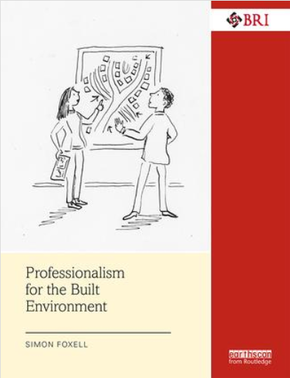Professionalism for the Built Environment
Professionalism for the Built Environment, was written by architect Simon Foxell and published by Routledge in August 2018.
Coming in the aftermath of the Grenfell Tower Fire, this 382-page book offers a thought-provoking assessment of the relationship between society, the economy and professionalism in the built environment. It considers the changing nature of professionalism, and the conflict between self-interest and the wider obligation professionals have to act in the public service, suggesting that there has been a move away from public service under the pressures of the market. Foxell contends that this has ‘shredded many of the core values of professionalism’.
The book outlines the history of professionalism, comparing the development of civil engineering, architecture and surveying. It examines how their systems have developed and where they are now, and highlights the prevalence and power of the large professional services companies.
The book suggests professionalism is under threat, and considers a number of options the professions might adopt for the future, whilst also asking difficult questions about ethics, training, education, public trust and expectations from within and from outside the industry. It concludes with a six-point plan for the professions if they are to remain relevant.
Foxell accepts there is no suggestion professionalism will become redundant, writing; ‘If anything, the need for the honest and impartial intermediary role will increase as society grapples with how to control ever more powerful market players and protect the interests of individuals and society.’
John Worthington, Co-founder of DEGW, former Commissioner of the Independent Transport Commission and Director of The Academy of Urbanism said; “Professionalism for the Built Environment raises our awareness of the foundations of professional society and sets the agenda for a radical reappraisal of the educational and institutional structures we may require in the future. This book stimulates debate on the professions’ responsibilities to civil society, company and self. It provides an authoritative briefing for practitioners, educators, clients and all concerned with creating a built environment that is equitable, fosters wellbeing and improves livelihoods.”
You can purchase Professionalism for the Built Environment at https://www.routledge.com/Professionalism-for-the-Built-Environment/Foxell/p/book/9781138900219
[edit] Related articles on Designing Buildings Wiki
- ARB code of conduct.
- Best practice.
- Conservation Professional Practice Principles.
- Construction industry institutes and associations.
- Ethics in construction.
- Giving professional advice to friends - a case study.
- How to give professional advice to friends.
- Practice.
- Professional conduct in the construction industry.
- Professional practice.
- Professional standards for architects.
- RIBA.
- RIBA professional conduct guidance.
- RICS.
- Submission of evidence to the Edge commission of inquiry on future professionalism.
- The Institution of Civil Engineers.
Featured articles and news
Latest Build UK Building Safety Regime explainer published
Key elements in one short, now updated document.
UKGBC launch the UK Climate Resilience Roadmap
First guidance of its kind on direct climate impacts for the built environment and how it can adapt.
CLC Health, Safety and Wellbeing Strategy 2025
Launched by the Minister for Industry to look at fatalities on site, improving mental health and other issues.
One of the most impressive Victorian architects. Book review.
Common Assessment Standard now with building safety
New CAS update now includes mandatory building safety questions.
RTPI leader to become new CIOB Chief Executive Officer
Dr Victoria Hills MRTPI, FICE to take over after Caroline Gumble’s departure.
Social and affordable housing, a long term plan for delivery
The “Delivering a Decade of Renewal for Social and Affordable Housing” strategy sets out future path.
A change to adoptive architecture
Effects of global weather warming on architectural detailing, material choice and human interaction.
The proposed publicly owned and backed subsidiary of Homes England, to facilitate new homes.
How big is the problem and what can we do to mitigate the effects?
Overheating guidance and tools for building designers
A number of cool guides to help with the heat.
The UK's Modern Industrial Strategy: A 10 year plan
Previous consultation criticism, current key elements and general support with some persisting reservations.
Building Safety Regulator reforms
New roles, new staff and a new fast track service pave the way for a single construction regulator.
Architectural Technologist CPDs and Communications
CIAT CPD… and how you can do it!
Cooling centres and cool spaces
Managing extreme heat in cities by directing the public to places for heat stress relief and water sources.
Winter gardens: A brief history and warm variations
Extending the season with glass in different forms and terms.
Restoring Great Yarmouth's Winter Gardens
Transforming one of the least sustainable constructions imaginable.























